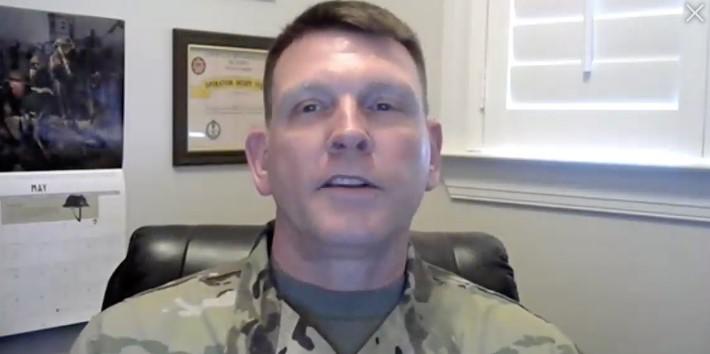Army Cyber Center Develops Training Pilot
The U.S. Army is creating a pilot program for a limited number of Signal Warrant Officers to build certain skills that the service is identifying as being crucial for the future digital battlefield. The program, currently being developed by the Army’s Cyber Center of Excellence (CCoE) at Fort Gordon, Georgia, will feature an online training platform for soldiers to access on-demand education when needed to support future signal, cyber and electronic warfare operations.
The pilot, which will run for at least a year once funding is secured, aims to build advanced skills within the fielded force, supplement and enhance institutional training, provide an annual skill refinement development pipeline, and provide insight to commanders and leaders when assessing skills and identifying growth areas, explained the incoming Command Chief Warrant Officer (CWO) at the CCoE, CWO 5 Paul Sankey, USA.
The program will also help inform the hiring process and support the Army Assignment Interactive Module (AIM) marketplace, the web-based platform the service uses to assist in officer management and talent management gap reduction.
Chief Sankey, along with three other panelists addressing future military training needs, spoke today during AFCEA International’s latest TechNet August Virtual Solutions Series, held May 18-19. It was the third episode of the series, with Episode 1 broadcast February 16-17 and Episode 2 held April 20-21, all leading up to the TechNet Augusta in-person conference to be held August 17-19 at the Augusta Marriott at the Convention Center in Georgia.
As a technical advisor to the CCoE, Chief Sankey is helping to shape the Army’s future training environment, looking next at the years 2028 through 2036. One of the center’s main missions is to train, educate and develop highly skilled signal, cyber and electronic warfare (EW) professionals that are able to support operations at both the strategic and tactical levels, Chief Sankey said. He acknowledged that it is a bit difficult to anticipate what warfighter capabilities will be required in the future, given the rapid pace at which technology is advancing.
“As signal, cyber and EW capabilities rapidly develop and evolve to enhance the Army's ability to compete, penetrate, disintegrate, exploit and recompete in multidomain operations or MDO, we strive to maintain the ability to adequately train our workforce to employ, maintain and provide instruction on these capabilities,” he stated.
To anticipate future educational requirements, the CCoE is monitoring the Army's capability development pipeline, emerging requirements and technologies advancing from the science and technology community—in addition to conducting the pilot. The battlefield of tomorrow will contain a plethora of networked devices, from vehicles to weapons systems and specialized sensors, including medical sensors directly attached to soldiers. These devices will flood the network with data, increasing the demand for bandwidth in a constrained environment, Chief Sankey offered.
As such, the Army—and the other services—need prepared warfighters that can harness data and streamline data schemas while maximizing the use of limited bandwidth. “As more and more applications move to the tactical server infrastructure, or TSI, and eventually to a true cloud environment, the network will become a landscape of software-defined networking and virtual infrastructure with a data-centric focus,” he noted. “The Command Post Computing Environment (CPCE) will be continuously fed with data from a variety of systems throughout the environment potentially requiring custom application programming interfaces, or APIs.”
Given the departure from configuring and administering physical systems, soldiers will need core skills in tactical cloud architecture, infrastructure-as-a-code, software-defined networking, structured and unstructured data management, scripting in coding languages and data visualization, the chief continued.
In addition, the application of artificial intelligence (AI) and machine learning will free up the workforce somewhat to perform other tasks. “As we find a novel way of applying artificial intelligence, such as with AI-enabled, noninteractive self-establishing and self-healing networks, intelligent interfaces to bridge the gap between user expertise and advanced technology knowledge requirements, and as quantum computing comes online to enable unprecedented processing power and speed, many of the tasks currently performed by the DoD workforce will be relieved,” Chief Sankey suggested.
And while industry certifications are required to perform digital functions at various levels, the certifications “are simply not a good indicator of an individual's true skills and the level of expertise,” the chief added. Moreover, when formal military education courses are not justified, but specific training is critical to units that require certain skills, the service must provide more on-demand education opportunities. Training must also be exercised in advance of deployment, for soldiers’ skills “to stay honed” in such an aggressively evolving technology environment, he emphasized.
The Army’s pilot program “aims to fill all of these gaps,” Chief Sankey shared.
Any future training must also provide soldiers with skills that foster a higher level of interoperability and coordination between the services, especially as the joint force develops Joint All Domain Command and Control (JADC2) for multidomain operations.
“Army command and control systems will feed JADC2, requiring complementary skill sets between the joint forces to ensure data access through APIs and data compatibility and normalization,” the chief stated. “As JADC2 cross service convergence progresses, we should seek joint educational opportunities to ensure the U.S. Armed Services and our mission partners are equipped with the skills needed to function as a whole.”





Comments